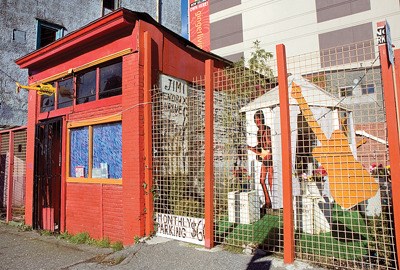When Wayde Compton tells people about the Hogan’s Alley Memorial Project, he’s often met with the same response: “They look at you with skepticism and confusion,” the author and historian says of his reference to Vancouver’s historical black community. Though awareness is greater today than it was when he started the project in 2002, most people in Vancouver still don‘t know the three-block stretch of Strathcona, between Union and Prior near Main Street, was for decades home to one of Vancouver’s most vibrant ethnic enclaves.
If you’d gone down to the neighbourhood in, say, the 1950s or ’60s, Hogan’s Alley would have been the epicentre of black culture in Vancouver.
Back then, the thriving, working-class neighbourhood featured some of the best jazz clubs and comfort food establishments the city had to offer. It was there that Compton’s parents met each other decades ago, and there that such notable black figures, from former MLA and B.C. legislative speaker Emery Barnes to guitar legend Jimi Hendrix, could be found winding down during off hours.
And it’s that community Compton and others would like to see acknowledged with a permanent, public memorial.
The neighbourhood’s residents were effectively evicted by city council circa-1970, when it opted to bulldoze the area in favour of the Georgia Street viaduct, part of an ill-fated attempt to bring freeways to Vancouver. While the other ethnic enclaves — Chinatown, Little Italy, Japantown — were spared by a community uprising against the initiative, Hogan’s Alley was the first and only casualty.
Today, a private shrine at the former workplace of Norah Hendrix (Jimi’s grandma) is the only indication Vancouver ever had a concentrated black community. Compton says the loss of the neighbourhood has essentially wiped the memory of a black community from Vancouver’s collective consciousness and continues to impact the way black people are perceived in the city’s contemporary cultural context.
“When Hogan’s Alley existed as a black neighbourhood, it seemed like Vancouverites knew they had a black population, it wasn’t this big mystery, nobody was saying there were no black people in Vancouver,” says Compton, who’s penned two books on the subject. “But as soon as that population integrated, then people say that. In fact, the percentage of blacks in the Lower Mainland to the general population is actually higher now, and yet people’s perception of the black community is less.”
Park Board commissioner Constance Barnes, daughter of Emery Barnes, agrees blacks are under-represented in Vancouver’s cultural dialogue.
“There is a great black community, but I don’t believe it is recognized,” she says, noting that while Vancouver city council was quick to celebrate the beginning of the Lunar New Year on Feb. 1, council waited until the middle of February to publicly acknowledge Black History Month, which began the same day.
“The fact that the proclamation was not read in city hall on Feb. 1 was very disappointing to the community.”
While Barnes says a Hogan’s Alley memorial is long overdue, she’d like to see the community recognized with something more substantial than a plaque.
Black people in the Lower Mainland need a home — a community centre, museum or library — where they can come together to learn about their shared history in this province and connect with one another, she says.
Ironically, she adds, it’s the lack of just such a space that’s preventing the kind of critical mass from forming that would pressure government to commit resources to a project of that size.
“It is difficult to get the black community to come together... and I think that is because we don’t have anywhere [to meet],” says Barnes. “We don’t have that community centre or library or a location that’s ours. We haven’t been recognized to that point.”
City councillor Geoff Meggs says he isn’t aware of any “organized pressure from the black community” for a community centre or museum space. “I’m sure if a proposal came forward, it would be considered seriously,” he says.
In the meantime, Meggs says he does support calls for a Hogan’s Alley memorial near the Georgia Viaduct, and with the city currently toying with the idea of tearing down the freeway vestige, the opportunity could arise in a possible future neighbourhood that would be built at that site.
“The potential for recreating a neighbourhood there is very exciting,” he says, “but we have to move carefully and make sure everyone understands what’s going on.”
The area under the viaduct is ripe for some sort of historical acknowledgement, Meggs added, since it has been the sit of several historically relevant decisions in the city’s life.
“It’s an important part of Vancouver history and there’s a whole generation that are unaware of it. Many people are unaware that the viaducts were part of a freeway system that was rejected, and they’re also unaware that Vancouver’s black community had its heart right there underneath the viaduct,” he says.
For Compton, a memorial in the area would be the first step in a long journey to have black history recognized, but it might just make the process easier. “As it is right now, we’re fighting this uphill battle,” he says. “You’re asking for funding for something, but at the same time, you’re telling people for the first time that this thing existed.”



